Setting Up Access Permissions for Phone Messages
For Phone Messages of a user, you can set the following permissions based on organizations, users, or roles.
- Access permissions
- Add Privileges
The permissions for phone messages vary by the security model applied to the messages.
The default setting is set to "REVOKE (All users have access except users on list)". Therefore, all users are allowed to view and add Phone Messages.
For information on permissions, refer to User Rights and Prioritized Access Permissions.
For the setting examples for each security model, refer to the following.
- If the Security Model Is GRANT (Only users on list have access)
- If the Security Model Is REVOKE (All users have access except users on list)
Setting User Rights
The example shows how to set access permissions when the security model is "GRANT (Only users on list have access)".
-
Click the administration menu icon (gear icon) in the header.
-
Click System settings.
-
Select "Application settings" tab.
-
Click Phone Messages.
-
Click Edit user rights.
-
On the "Edit user rights" screen, select departments, users, or roles to set.
-
On "User rights" screen, check that the security model is "GRANT (Only users on list have access)".
If the security model is set as "REVOKE (All users have access except users on list)", click Change to change the setting to "GRANT (Only users on list have access)". For details, refer to Changing the Security Model.
-
Click Add.

-
On the "Add new entry" screen, select the organization, user, or role, and then click Add.
To select a role, switch the view to the Roles tab.
After you click Add then click the tab, the selected departments, users, or roles before you switch tabs are cleared.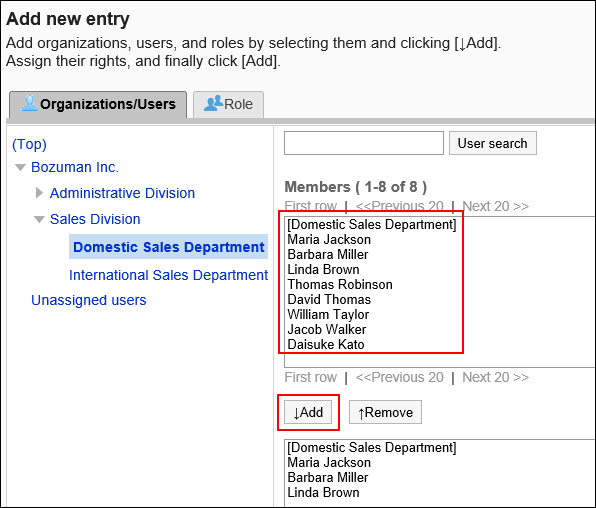
-
Under "User rights", select the checkbox for "View" and click Add.

Combination of User Rights
When you control user actions of Phone Messages by permissions, only links on which the logged in users can work with are activated on their screens.
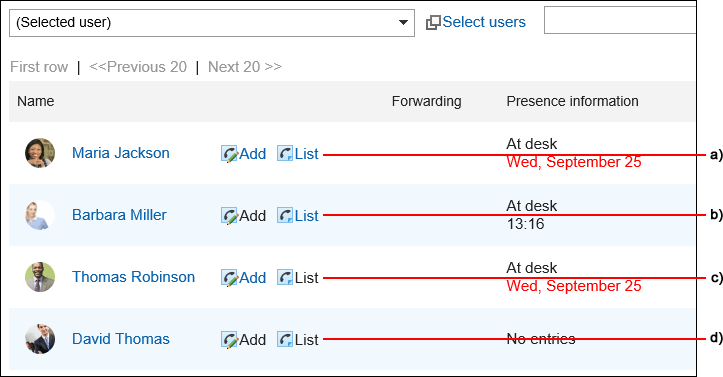
When both a user and a department or a role to which the user belongs have access permissions to a phone message, the access permission that the user has overrides the other. For details, refer to When Organizations, Users, and Roles Have Different Permissions.
If the security model is "GRANT (Only users on the list have access)"
The example shows that the case in which the access permission security model for Osamu Kimura is "GRANT (Only users on list have access)".
- Example of allowing Daisuke Kato to perform all the actions on Osamu Kimura's items:
Grant Daisuke Kato permissions to view and add phone messages.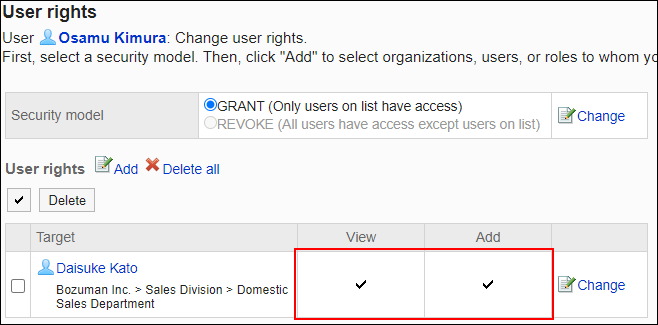
- Example of allowing Daisuke Kato to perform only view phone message actions on Osamu Kimura's phone messages:
Grant Daisuke Kato a permission to view items.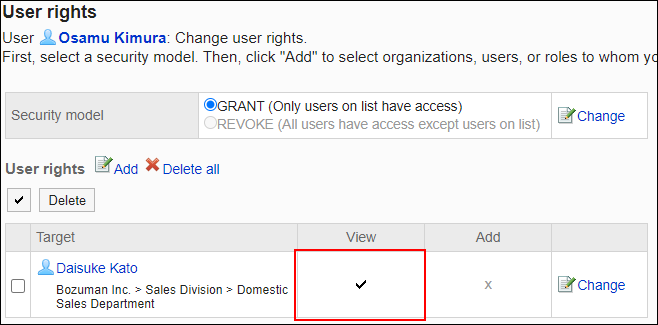
- Example of allowing Osamu Kimura to perform only add phone message actions:
Grant Daisuke Kato a permission to add items.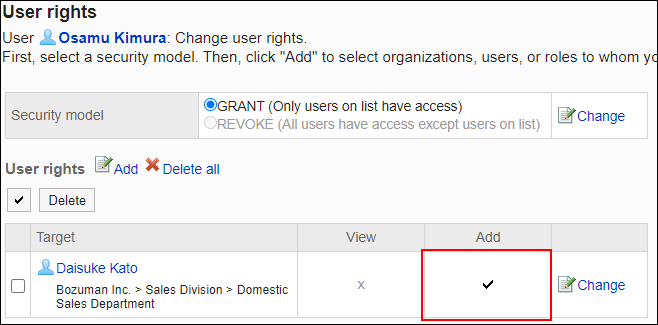
- Example of prohibiting Daisuke Kato to perform all the actions on Osamu Kimura's items:
Delete Daisuke Kato from the user rights list.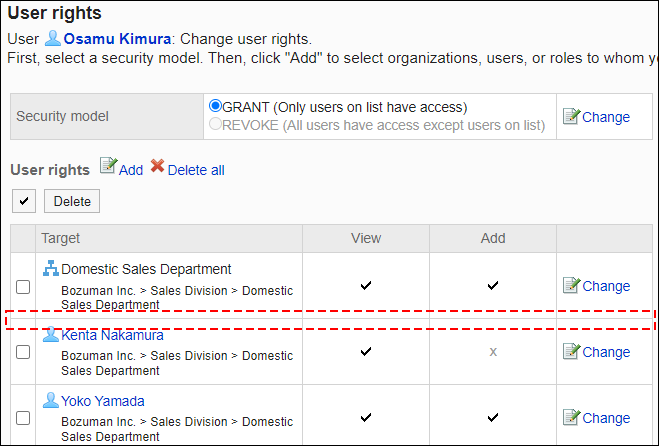
If the security model is "REVOKE (All users have access except users on the list)"
The example shows that the case in which the access permission security model for Osamu Kimura is "REVOKE (All users have access except users on list)".
- Example of prohibiting Daisuke Kato to perform all the actions on Osamu Kimura's items:
Delete permissions to view and add items from Daisuke Kato.
- Example of prohibiting Daisuke Kato to perform view phone message actions on Osamu Kimura's phone messages:
Delete a permission to view appointments from Daisuke Kato.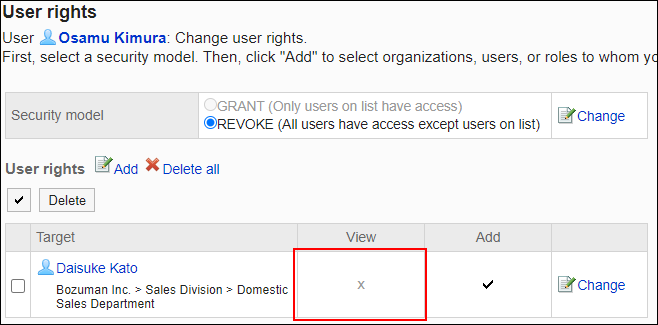
- Example of prohibiting Daisuke Kato to perform add phone message actions on Osamu Kimura's items:
Delete a permission to add phone messages from Daisuke Kato.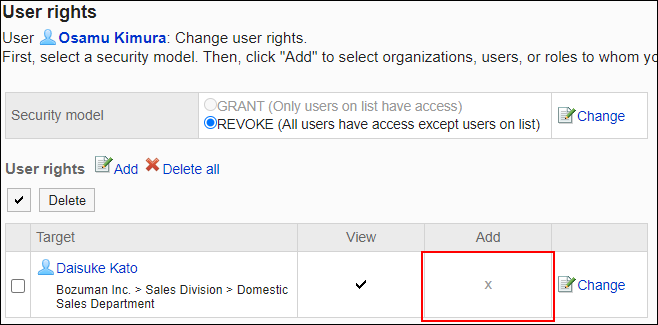
- Example of allowing Daisuke Kato to perform all the actions on Osamu Kimura's items:
Delete Daisuke Kato from the user rights list.
Changing User Rights
Change access permissions granted to users and departments.
-
Click the administration menu icon (gear icon) in the header.
-
Click System settings.
-
Select "Application settings" tab.
-
Click Phone Messages.
-
Click "Edit user rights".
-
On the "Edit user rights" screen to set user rights, select the organization, user, or role to change the user rights.
-
On "User rights" screen, click Edit to change the permission.
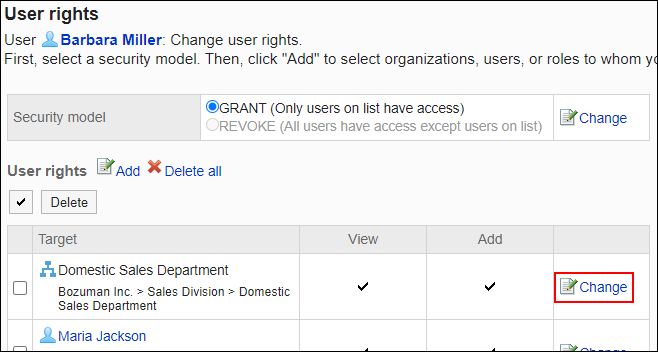
-
On "Edit user rights" screen, you can change the user rights as needed.
-
Confirm your settings and click Save.
Deleting User Rights
Delete access permissions granted to users and departments.
If you delete user rights, actions that users can perform changes as follows depending on the security model:
- If the security model is "GRANT (Only users on list have access)":
Users who were deleted the user rights or users who belonged to the departments or roles that lost user rights no longer be able to work with items they previously could. - If the security model is "REVOKE (All users have access except users on list)":
Users who were deleted the user rights or users who belonged to the departments or roles that lost user rights can now work with items they prohibited to use.
Selecting and Deleting User Rights
Select and delete user rights.
-
Click the administration menu icon (gear icon) in the header.
-
Click System settings.
-
Select "Application settings" tab.
-
Click Phone Messages.
-
Click Edit user rights.
-
On the "Edit user rights" screen, select departments, users, or roles to set.
-
On "User rights" screen, select the checkboxes of the permissions to delete, and then click Delete.
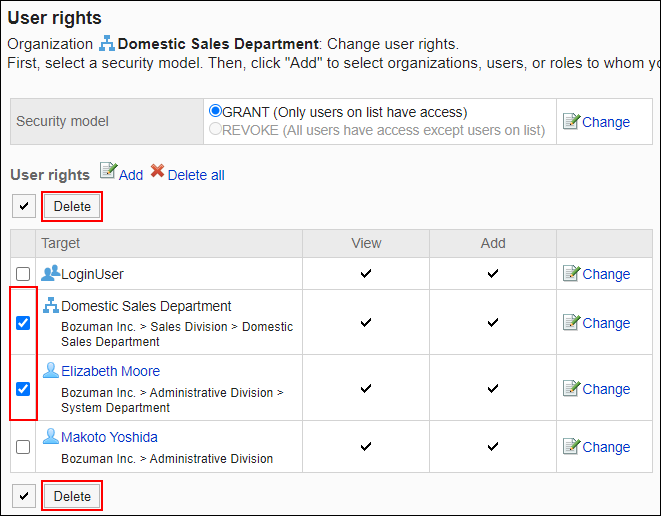
-
Click Yes on "Delete user rights" screen.
Deleting All User Rights
Delete all user rights.
-
Click the administration menu icon (gear icon) in the header.
-
Click System settings.
-
Select "Application settings" tab.
-
Click Phone Messages.
-
Click Edit user rights.
-
On the "Edit user rights" screen, select departments, users, roles, facility groups, or facilities to set.
-
On "User rights" screen, click "Delete all".

-
Click Yes on "Delete all user rights" screen.